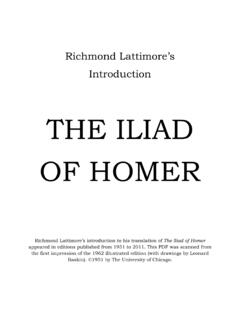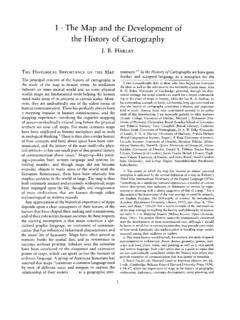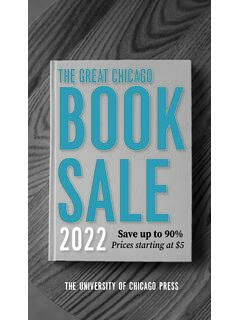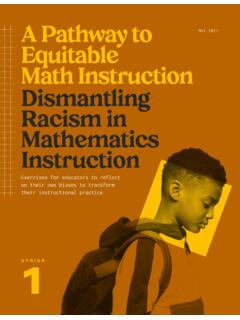Transcription of Writing Your Journal Article in Twelve Weeks
1 Writing your Journal Article in Twelve WeeksA Guide to Academic Publishing SuccessSecond editionWendy Laura BelchertHe UniVeRSitY oF cHicAGo PReSS cHicAGo And LondonContentsPReFAce to tHe Second edition ixAcknowLedGmentS xiINTRODUCTION: Using This workbook 1 The workbook s goals, field- tested nature, pragmatic emphasis, radical audience, revision focus, and instructions: Using the print or electronic version. Completing tasks. Following disciplinary tracks and stage pathways. Using the workbook according to your temperament; by yourself; in a Writing group; with a Writing partner; with coauthors; or to teach a class or publishing terms and processes: What is a Journal ?
2 What is an Article ? What processes do Journal articles go through?Giving feedback to authorWEEK 1: designing your Plan for Writing 14 Instruction: Understanding feelings about Writing . Keys to positive Writing experiences: suc-cessful academic writers write; read; make Writing social; persist despite rejection; and pursue their tasks: designing a plan for submitting your Article in Twelve Weeks . Day 1, reading the workbook . Day 2, designing your Writing schedule. Day 3, selecting a paper for revision. Day 4, re-reading your paper to identify revision tasks. Day 5, setting up your Writing site, citation software, and file backup system; addressing coauthorship; and reading a Journal 2: Advancing your Argument 60 Instruction: Myths about publishable Journal articles: being profoundly theoretical, packed with ideas, and entirely original.
3 What gets published and why: how publishable articles pair evidence and approaches. What gets rejected and why: perfectly acceptable articles and those with no argu-ment. Understanding and making arguments: what is an argument; how do you know whether you have one; how do you make strong arguments; and how do you write an argument- driven Article ? your tasks: Organizing your Article around your argument. Day 1, reading the workbook . Day 2, testing out your argument. Day 3, reviewing your Article for argument. Days 4 5, revising your Article around your 3: Abstracting your Article 90 Instruction: Abstracts as a tool for success.
4 Ingredients of a good abstract: good SciQua and HumInt tasks: Crafting an effective abstract. Day 1, talking your way to clarity about your Article . Day 2, reading others abstracts and drafting your own. Day 3, reading strong articles in your field. Day 4, reading articles to cite in your Article . Day 5, getting feedback on and revising your 4: Selecting a Journal 110 Instruction: Good news about journals. The importance of picking the right Journal . Types of academic journals: nonrecommended, debatable, and preferred publishing tasks: Finding suitable academic journals. Day 1, reading the workbook .
5 Day 2, searching for journals. Days 3 4, evaluating academic journals. Day 5, reading relevant journals and Writing query 5: Refining your Works Cited 150 Instruction: Reading scholarly texts. Types of scholarly texts: primary, original, or exhibit sources; scholarly or secondary literature; and derivative or tertiary documents. Advice for schol-ars at resource- poor institutions. Strategies for citing your reading: common mistakes in citing texts; establishing your citation values ; avoiding improper borrowing; good citation habits; and post- borrowing solutions.
6 Strategies for getting reading done: reading theoretical literature; re-lated literature; and original, primary, or exhibit literature. Strategies for Writing your related- literature review: what s your entry point; what is a related- literature review; and how do you write a methodological- or theoretical- literature review? your tasks: Writing about others research. Day 1, reading the workbook . Day 2, evaluating your current Works Cited list. Day 3, identifying and reading any additional works. Day 4, identifying your entry point into the related literature. Day 5, Writing or revising your related- literature 6: Crafting your Claims for Significance 190 Instruction: On the difference between arguments and claims for significance.
7 What is a claim for significance: types of claims; examples of claims; making claims; and the So What? exercise. Types of feedback: what to do (and not do) when giving and receiving tasks: Claiming significance. Day 1, reading the workbook . Day 2, exchanging Writing and doing the So What? exercise. Day 3, Writing and inserting your claims for significance. Days 4 5, revising your Article according to feedback 7: Analyzing your Evidence 216 Instruction: Analyzing evidence. Types of evidence: textual; qualitative; quantitative; and tasks: Revising your evidence.
8 Day 1, reading the workbook . Day 2, highlighting and analyz-ing your evidence. Day 3, analyzing the quality, relevance, and placement of your evidence. Day 4, analyzing your interpretation of your evidence. Day 5, collecting additional 8: Presenting your Evidence 238 Instruction: Presenting evidence in SciQua articles, in HumInt articles, and in illustrations; ob-taining image or text tasks: Revising your presentation of evidence. Day 1, reading the workbook . Days 2 4, re-vising your presentation of evidence. Day 5, checking your presentation of evidence by 9: Strengthening your Structure 256 Instruction: On the importance of structure.
9 Article - structuring principles: macrostructure and microstructure; structural building blocks; rhetorical orders of structure; structure signals; and com-mon genres structures. Types of Journal Article macrostructures: SciQua; HumInt; disciplinary; and synaptic macrostructure. Types of pre- and postdraft tasks: Revising your structure. Day 1, reading the workbook . Day 2, outlining someone else s published Article . Day 3, making a postdraft outline of your Article . Days 4 5, restructuring your 10: Opening and Concluding your Article 280 Instruction: On the importance of openings: fashioning your title; molding your introduction; and choosing your name.
10 On the importance of tasks: Finalizing your opening and conclusion. Day 1, reading the workbook and revising your title. Day 2, molding your introduction. Day 3, molding your introduction and choosing your name. Day 4, revising your abstract and author order. Day 5, constructing your 11: Editing your Sentences 308 Instruction: The nature of microrevising. The Belcher Editing Diagnostic Test and its prin-ciples: reduce lists; strengthen verbs; clarify pronouns; decrease prepositions; and cut unnecessary tasks: Editing your Article . Day 1, Reading the workbook and running the Belcher Editing Diagnostic Test.







